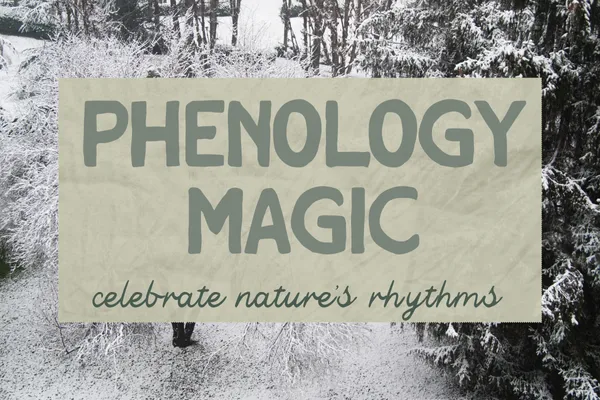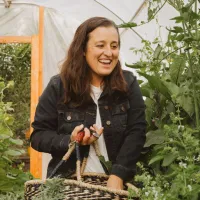
Discover the Magic of Phenology

Discover the Art of Phenology: Connect with Nature Through the Seasons
Do you scroll through your photos to see what you garden looked like at this time of year too? Shouldn't the snow be gone by now? Wasn't I planting at this time last year? I can't plant my garden until the snow is melted off Castle Peak. Or if you don't have a garden yet, weren't the trails rideable by now last year? Why is it still so muddy? Or maybe you're a flower person. Where are the lilacs, they should have popped by now? Or for the hikers, haven't the serviceberries blanket the hills in white earlier this year? Sound familiar? Congrats, you're a budding PHENOLOGIST!
Here in the mountains, where snow fall and melt and wildlife migrations define the ebb and flow of our adventure de jour (and even our county's population), phenology offers a unique way to deepen your connection to seasonal cycles. It’s more than observation—it’s a way to align with the rhythms of nature, benefiting not only your garden but also your well-being and the planet.
While gardening advice often nudges us toward rigid calendar dates—like THE last frost date or those USDA planting zones—it’s really nature that calls the shots, deciding which plants thrive and when in any given year. This year let's lean into the seasonal rhythms of nature, celebrating each as they pass, planting salad greens starting when the lilac blooms until the geese head south.
If you aren't ready to garden by seasonal cues yet, at least take notice of them with the practice of phenology and celebrate with us our during our🛞Wheel of Seasons series of events! But, what is phenology anyways? Read on to learn!

In this blog you'll learn:
What is Phenology? Discover how tracking nature’s changes fosters mindfulness and connection.
Why Phenology Matters for Gardeners: Unlock the secrets of planting and harvesting success by following nature’s cues.
Simple Ways to Practice Phenology: Easy-to-follow tips for incorporating this practice into your daily life.
Celebrate the Seasons with Community: Learn how our workshops turn seasonal observations into meaningful experiences.
Do you {bean}stalk us on instagram yet? Give us a follow @wigglewormgardens

What Is Phenology and Why Does It Matter?
At its core, phenology is the study of how plants, animals, and weather respond to seasonal changes. From the timing of aspen leaves turning golden to the return of hummingbirds in spring, these patterns create a natural calendar that helps us understand our environment.
For gardeners in mountain communities like Eagle, Garfield, and Pitkin counties, phenology is an invaluable tool. Tracking frost dates, bloom times, and pollinator activity can help you adapt your gardening practices to the unique challenges of high-altitude living.
💡 Try this: Start by observing one natural event in your area, such as the blooming of a specific wildflower or the first snowmelt in your garden. By recording these changes over time, you’ll develop a richer understanding of nature’s rhythms.

The Benefits of Practicing Phenology
Practicing phenology isn’t just for scientists—it’s for anyone who wants to slow down and reconnect with the natural world.
Personal Benefits:
Cultivate mindfulness as you pause to notice seasonal shifts. This practice can also help combat seasonal stress or 'winter blues,' offering a sense of calm and connection during colder months.
Deepen your appreciation for the intricate patterns of life around you.
Strengthen your connection to your place and its unique ecosystem.
Ecological Benefits:
Help track local climate trends by observing nature’s changes. Citizen science programs like the North American Breeding Bird Survey have shown how collective efforts to document migratory bird patterns contribute to valuable climate and ecological research, highlighting the power of community science in understanding seasonal rhythms.
Support biodiversity by aligning your gardening practices with seasonal cues such as making sure that you have flowers blooming when the first pollinators emerge from winter dormancy.
Gardening Benefits:
Avoid pest issues by noticing when insects appear and act accordingly. If spring flea beetles are wrecking your brassica family plants, try again in late summer when their populations have dwindled. Perhaps spinach leaf miners decimate your greens in early summer; overwintered spinach produces abundant harvests in early to late spring before the miners emerge.
Notice when native plants and weeds of the same family start sprouting as a starting point to guide your planting. Shepard's purse and blue mustard pop up as the first weeds in my garden. Their arrival means I can plant arugula, a hardy green in the mustard family along with those weeds.
👉 Looking for tips on gardening in the mountains? Explore our Growing Tips selection of blog posts.


How to Start Practicing Phenology
Starting a phenology practice is simple and rewarding. Here’s how to begin:
Choose a Spot: Pick an easily accessible location, such as your backyard or a nearby trail, and visit it regularly. When the kids were little, we tracked the comings and goings of birds in our backyard since we were home a lot. Now that we're older, we like to visit Salt Creek Open Space regularly for observations while we "hike."
Keep a Journal: Use a notebook, digital app, or even a simple calendar to jot down your observations. For the littlest phenologists, have them choose a few colors that they notice and have them scribble on a section of paper plate. For artistic folks, there is absolutely stunning inspiration easily found on Pinterest. (But don't be discouraged if you don't draw well; that's not the important part!)
Focus Your Observations: Start with one or two things, such as blooming flowers, migrating birds, or weather patterns.
Create a Phenology Wheel: A fun, visual way to record observations through the seasons. Draw a circle divided into months, and note key changes in nature for each one.
👩👦 Practicing with kids? For a preschoolers, check out Hands On As We Grow and for older kids, try Aspen Center for Environmental Studies

Celebrating the Seasons with Community
Noticing and celebrating natural patterns is a soothing anecdote to the hectic modern life where so much clamors for our attention. Our Celebrate the Seasons Workshop Series brings people together to learn, observe, and celebrate the cycles of nature.
Here’s a sneak peek at what’s planned for 2025:
Halfway to Spring = Seed Swap: A community gathering to share seeds and sharpen tools.
Spring Equinox = Seed Starting: Plant the seeds of your spring garden.
Halfway to Summer = Salad Planting: Learn how to grow fresh greens for summer meals.
Summer Solstice = Nature Crafts: Mark the longest day with fun, creative projects.
Halfway to Fall = Preserving Workshop: Learn how to preserve the incoming bounty.
Fall Equinox = Garden Reflections: Celebrate the harvest with leaf art and storytelling.
Halfway to Winter = Harvest Festival: Enjoy pumpkins, cider, and cozy decor.
Winter Solstice = Fire and Friendship: Gather around the fire to welcome the longest night.
No garden is required—just bring your curiosity and enthusiasm!
📆 Check out the full event schedule to join us for a season of growth, learning, and connection. 🌸

Phenology invites us to slow down, observe, and savor the rhythms of nature—a practice that enriches our gardens, our communities, and our lives. By simply noticing the changes in the world around us, we become more attuned to the cycles that sustain us. Our Celebrate the Seasons Workshop Series offers the perfect way to start—join us to turn your observations into meaningful actions while connecting with like-minded nature enthusiasts.
Ready to start your journey toward seasonal celebration? Share your phenology observations with us by tagging @wigglewormgardens on Instagram or Facebook. Better yet, join us at an upcoming workshop to dive deeper into this beautiful practice.
For more tips and inspiration, explore our event calendar and garden-centered life blog posts. Together, let’s celebrate the seasons and embrace the wonder of the natural world. 🍂

Copyright 2023-2025 Wiggle Worm Gardens
Visit Our Sister companies
Fourth Street Farm: edible landscaping and raised bed garden design and installation
Ground Up: Soil health and compost tea

